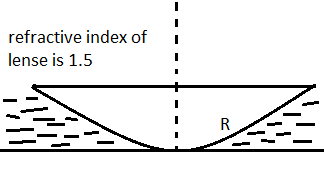
The focal length of a plano convex lens is $'f'$ and its refractive index is $1.5$. It is kept over a plane glass plate with its curved surface touching the glass plate. The gap between the lens and the glass plate is filled by a liquid. As a result, the effective focal length of the combination becomes $2f$. Then the refractive index of the liquid is
A. $1.25$
B. $1.33$
C. $1.5$
D. $2$
Answer
573k+ views
Hint: We can solve this question with help of lens maker formulas. Lens is the piece of transparent material that has two curved surfaces . There are many types of lenses such as plano convex, convex, concave, plano concave etc. The formula which is used for calculation of focal length is $\dfrac{1}{F} = \dfrac{1}{V} + \dfrac{1}{u}$
Where $F,V,u$ is focal length of lens, distance of image from the lens and distance of object from the lens respectively.
Complete step by step answer:
If we combine the two lenses of different or same focal length , a new combination of lens is formed and its focal length can be calculated with the lens maker formula . The focal length of a lens depends upon the refractive index of the lens and the radius of its curvatures. Lens maker formula is written as follows:
$\dfrac{1}{f} = \left( {\mu - 1} \right)\left( {\dfrac{1}{{{R_1}}} - \dfrac{1}{{{R_2}}}} \right)$ , where $f$ is the focal length of the combination, $\mu $ is refractive index of lens and ${R_1},{R_2}$ is the radius of curved surfaces respectively.
For the given question figure is as follows :

From the lens maker formula, focal length of plano convex lens is $\dfrac{1}{f} = \left( {1.5 - 1} \right)\left( {\dfrac{1}{{ - \infty }} - \dfrac{1}{{ - R}}} \right)$
For the plan surface of the lens if ${R_1} = - \infty $, and curved surface ${R_2} = - R$.
So,
$
\dfrac{1}{f} = \dfrac{1}{{2R}} \\
\Rightarrow f = 2R \\
$
Now, we can assume the fluid below the combination lens as a plano concave lens of refractive index of $\mu $ and focal length of $f'$ . So,
$\dfrac{1}{{f'}} = \dfrac{{1 - \mu }}{R}$
For new combination focal length is, $\dfrac{1}{F} = \dfrac{1}{{f'}} + \dfrac{1}{f}$, focal length for this lense is given in question i.e. $2f$.
$\dfrac{1}{{2f}} = \dfrac{1}{f} + \dfrac{{1 - \mu }}{R} \Rightarrow \dfrac{{1 - \mu }}{R} = \dfrac{{ - 1}}{{2f}} = \dfrac{{ - 1}}{{4R}}$
$
\Rightarrow 1 - \mu = 0.25 \\
\Rightarrow \mu = 1.25 \\
$
Then the refractive index of the liquid is 1.25. Option A is the correct answer of the given question.
So, the correct answer is “Option A”.
Note:
The lenses are used in different optical instruments such as telescope, microscopes . These instruments are made up of different combinations of different focal lengths. We use lens maker formulas for the manufacturing lenses of the desired focal length.
Where $F,V,u$ is focal length of lens, distance of image from the lens and distance of object from the lens respectively.
Complete step by step answer:
If we combine the two lenses of different or same focal length , a new combination of lens is formed and its focal length can be calculated with the lens maker formula . The focal length of a lens depends upon the refractive index of the lens and the radius of its curvatures. Lens maker formula is written as follows:
$\dfrac{1}{f} = \left( {\mu - 1} \right)\left( {\dfrac{1}{{{R_1}}} - \dfrac{1}{{{R_2}}}} \right)$ , where $f$ is the focal length of the combination, $\mu $ is refractive index of lens and ${R_1},{R_2}$ is the radius of curved surfaces respectively.
For the given question figure is as follows :

From the lens maker formula, focal length of plano convex lens is $\dfrac{1}{f} = \left( {1.5 - 1} \right)\left( {\dfrac{1}{{ - \infty }} - \dfrac{1}{{ - R}}} \right)$
For the plan surface of the lens if ${R_1} = - \infty $, and curved surface ${R_2} = - R$.
So,
$
\dfrac{1}{f} = \dfrac{1}{{2R}} \\
\Rightarrow f = 2R \\
$
Now, we can assume the fluid below the combination lens as a plano concave lens of refractive index of $\mu $ and focal length of $f'$ . So,
$\dfrac{1}{{f'}} = \dfrac{{1 - \mu }}{R}$
For new combination focal length is, $\dfrac{1}{F} = \dfrac{1}{{f'}} + \dfrac{1}{f}$, focal length for this lense is given in question i.e. $2f$.
$\dfrac{1}{{2f}} = \dfrac{1}{f} + \dfrac{{1 - \mu }}{R} \Rightarrow \dfrac{{1 - \mu }}{R} = \dfrac{{ - 1}}{{2f}} = \dfrac{{ - 1}}{{4R}}$
$
\Rightarrow 1 - \mu = 0.25 \\
\Rightarrow \mu = 1.25 \\
$
Then the refractive index of the liquid is 1.25. Option A is the correct answer of the given question.
So, the correct answer is “Option A”.
Note:
The lenses are used in different optical instruments such as telescope, microscopes . These instruments are made up of different combinations of different focal lengths. We use lens maker formulas for the manufacturing lenses of the desired focal length.
Recently Updated Pages
Master Class 12 Social Science: Engaging Questions & Answers for Success

Master Class 12 Physics: Engaging Questions & Answers for Success

Master Class 12 Maths: Engaging Questions & Answers for Success

Master Class 12 Economics: Engaging Questions & Answers for Success

Master Class 12 Chemistry: Engaging Questions & Answers for Success

Master Class 12 Business Studies: Engaging Questions & Answers for Success

Trending doubts
What are the major means of transport Explain each class 12 social science CBSE

Which are the Top 10 Largest Countries of the World?

Draw a labelled sketch of the human eye class 12 physics CBSE

How much time does it take to bleed after eating p class 12 biology CBSE

Explain sex determination in humans with line diag class 12 biology CBSE

Explain sex determination in humans with the help of class 12 biology CBSE




